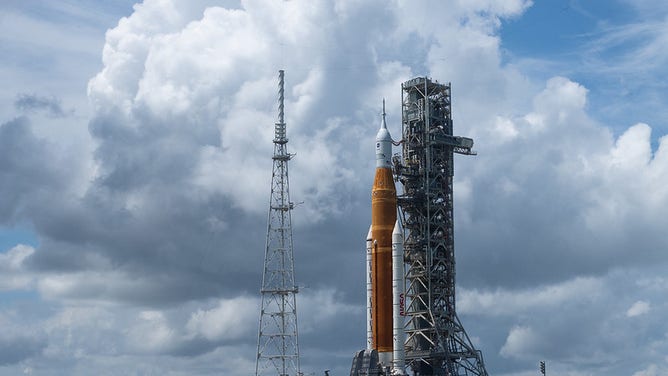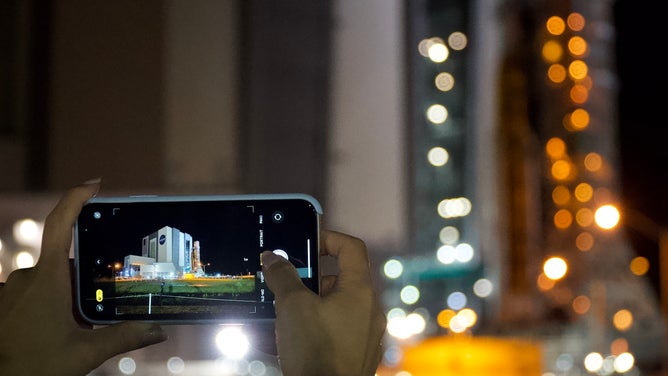Artemis 1: NASA hoping for late-September launch if moon rocket is fixed in time
If NASA can fix a hydrogen leak, conduct a fueling test and get permission from Space Force, another Artemis 1 launch attempt could happen on Sept. 27 or Oct. 2.

NASA’s Space Launch System (SLS) rocket with the Orion spacecraft aboard is seen atop the mobile launcher at Launch Pad 39B, Tuesday, Aug. 30, 2022, at NASA’s Kennedy Space Center in Florida. NASA’s Artemis I flight test is the first integrated test of the agency’s deep space exploration systems: the Orion spacecraft, SLS rocket, and supporting ground systems. Photo Credit: (NASA/Joel Kowsky)
(NASA)
KENNEDY SPACE CENTER, Fla. – NASA leaders are hopeful they can launch the Artemis 1 mission before the end of September. However, the Space Launch System rocket must first undergo repairs, and the U.S. Space Force would need to approve.
Most recently, NASA began fueling the Space Launch System rocket with the uncrewed Orion spacecraft during a countdown on Saturday from Kennedy Space Center in Florida. However, a fuel leak of liquid hydrogen to the SLS caused the launch director to scrub the liftoff after engineers couldn't solve the problem in time.
NASA is attempting to launch the SLS and Orion on a test flight around the moon as the space agency prepares to launch astronauts on a similar mission next year and ultimately land humans on the moon for the first time in 50 years.
Technical issues caused two previous scrubs, first due to a sensor error on one of the rocket's four RS-25 engines on Aug. 29 and then a major liquid hydrogen leak on Saturday, Sept. 3.
NASA announced Monday that they have adjusted the targeted dates and will now aim to test no earlier than Wednesday, Sept. 21.
The space agency is working to fix the leak, and during the scheduled test, they can check the seal while fueling the rocket.
If the test goes well, NASA has requested an extension from U.S. Space Force, which oversees the Eastern Range, to attempt a launch on Sept. 27 or Oct. 2.
Teams are also working on the upcoming launch of the SpaceX Crew-5 mission that is expected to launch on Monday, Oct. 3. NASA and SpaceX are working on the upcoming crewed launch in parallel to the Artemis I planning, and both launch schedules will continue to be assessed over the coming weeks.
"The updated dates represent careful consideration of multiple logistical topics, including the additional value of having more time to prepare for the cryogenic demonstration test, and subsequently more time to prepare for the launch. The dates also allow managers to ensure teams have enough rest and to replenish supplies of cryogenic propellants," NASA said Monday.
Previously, NASA said the 322-foot-tall moon rocket would need to roll back to the Vehicle Assembly building due to safety requirements to replace the flight termination system (FTS) batteries. The flight termination system is required on all rockets and would cause the vehicle to self-destruct if it veers off course and threatens the public.
WHAT IS NASA'S ARTEMIS 1 MISSION GOING TO DO?
Free said the agency submitted a waiver to extend the FTS certification and is waiting to hear back from Space Force.
"We're pressing for the tanking test that's in our forefront," Free said. "If the range has questions, obviously, we'd like to hear from them. But we're following their process. So right now, we submitted the waiver, and we'll look to hear from them on any clarifications that they need from us when we get closer to the tanking test. Obviously, we'll have to make a decision after that if we don't have a decision from the range."
NASA's SLS chief engineer John Blevins said FTS batteries are located on each stage of the rocket, but the "heart of the system" is the bright orange core stage.
"The batteries in question, what we're talking about, are core stage batteries, they are different than the other systems and because of their size and that they're a little more prone to meeting that retest evaluation," Blevins said.
Free said NASA has been working with the Director of the Eastern Range, Brig. Gen. Stephen G. Purdy and his team ensuring all safety requirements and concerns are met.
Leaky hydrogen plagues SLS

NASA’s Space Launch System (SLS) rocket with the Orion spacecraft aboard is seen atop a mobile launcher at Launch Pad 39B, Wednesday, Aug. 17, 2022, after being rolled out to the launch pad at NASA’s Kennedy Space Center in Florida. NASA’s Artemis I mission is the first integrated test of the agency’s deep space exploration systems: the Orion spacecraft, SLS rocket, and supporting ground systems. Launch of the uncrewed flight test is targeted for no earlier than Aug. 29. Photo Credit: (NASA/Joel Kowsky)
The SLS requires more than 700,000 gallons of supercold liquid hydrogen and liquid oxygen propellant to provide the fuel to lift the 322-foot-tall rocket off the launchpad and into space. While an efficient rocket fuel, hydrogen is a tiny molecule that easily leaks and also created problems for the space shuttle program.
SLS has also experienced hydrogen leaks during wet dress rehearsal tests and a small leak during the first launch attempt. NASA managers said the most recent leak was considered a major leak.
To fix the leak, engineers have built a plastic tent around the hardware to protect it from the elements as they replace several seals.
Mike Bolger, NASA Exploration Ground Systems program manager, said there is cooling for the team inside the enclosure to combat the Florida heat.
After completing the work, NASA will test the work by fueling the rocket with 700,000 gallons of minus-423-degree propellant.
Mike Bolger, NASA Exploration Ground Systems program manager, said they would fully tank both core stage and upper stage through all three phases of fueling, including slow fill, fast fill and replenish.
"We're really just trying to prove that we've got a good seal," Bolger said.
ARTEMIS DELAYED: HOW LONG DID IT TAKE NASA TO LAUNCH THE FIRST SPACE SHUTTLE IN COMPARISON?
Bolger said teams should replace an 8-inch seal by Thursday afternoon and then move on to a 4-inch seal later in the day if the weather allows.
Teams can work on the rocket even during a Phase 2 lightning storm because of the lightning protection system around the launchpad.
"The three 550-foot towers that we've got out and the catenary wire, so far has proven really effective in protecting the launch vehicle through a couple of tough storms where those towers did take strikes and again, protected the vehicle extremely well," Bolger said.
NASA's mega moon rocket has survived lightning strikes without issue, including the most powerful strike ever recorded at Kennedy Space Center.
Potential launch dates

A person takes a photo of NASA's Space Launch System rocket and Orion spacecraft making the journey to Kennedy Space Center launchpad 39B on Aug. 16, 2022. (Image: Brandy Campbell/FOX Weather)
NASA needs to consider the Earth and moon alignment and can only launch the SLS on select days. The next launch window opens in mid-September.
If the range approves NASA's extension, the Sept. 23 launch window opens at 6:47 a.m., and the Orion would splash down in the Pacific on Oct. 18. A Sept. 27 launch window would open at 11:37 a.m. with Orion's return on Nov. 5.
"We need to get the tanking test done, and then we'll have to look at what is the realism and schedule for us for the launch period," Free said.
Due to the upcoming SpaceX Crew-5 astronaut launch in early October, a mid-October launch is possible if NASA cannot launch by the end of September.